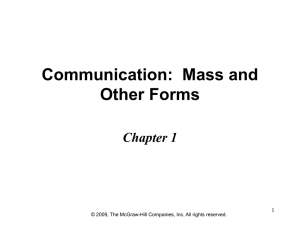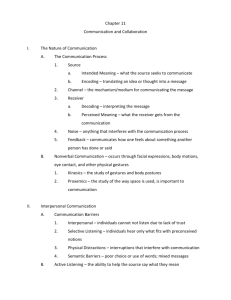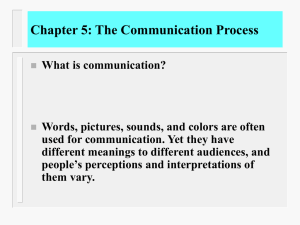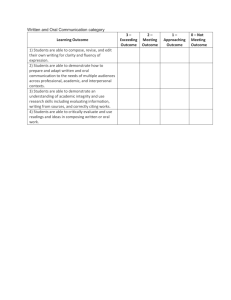Chapter 1 PowerPoint
advertisement
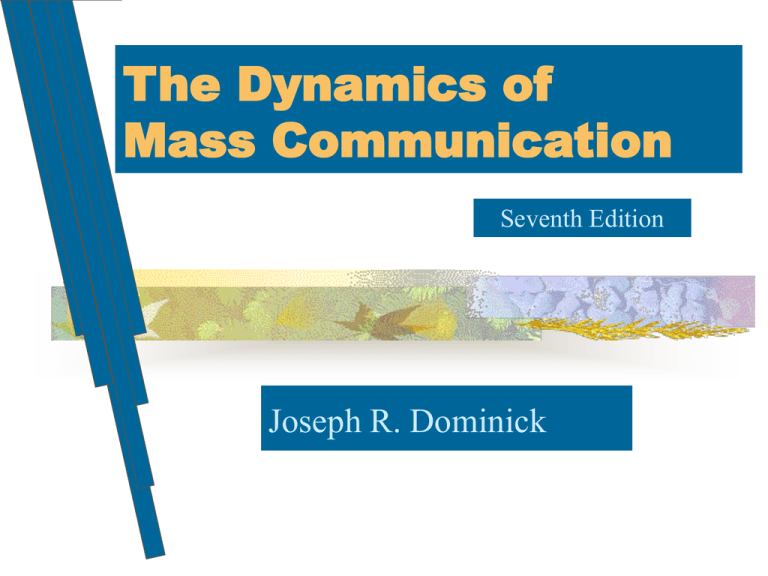
The Dynamics of Mass Communication Seventh Edition Joseph R. Dominick Part 1 The Nature and History of Mass Communications Chapter 1 Communication: Mass and Other Forms 8 Elements of the Communication Process • • • • Encoding Source Message Channel • • • • Receiver Feedback Noise Decoding The Communication Process Communication Settings Interpersonal Communication Machine-Assisted Communication Mass Communication Interpersonal Communication Source can be an individual or group Receiver can be an individual or group Encoding is usually a one-step process Variety of channels usually available Messages hard for receiver to terminate Interpersonal (Continued) Produced at little or no expense Messages are generally private Message can pinpoint specific targets Feedback is immediate Machine-Assisted Communication Source may be an individual or group May or may not be easy to identify Source may or may not have first-hand knowledge of the receiver Encoding can be simple to complex Two encoding stages: 1. source translates thoughts into symbols 2. encodes message for transmission/storage Machine-Assisted (Continued) Encoding may require several stages Two encoding stages: 1. source translates thoughts into symbols 2. encodes message for transmission/storage Channel options more restricted than interpersonal communication Variety of channels usually available Machine-Assisted (Continued) Machine-assisted messages have at least one machine between source and receiver Message customizability varies Messages can be both private or public Messages relatively inexpensive to send Ease of ending communication varies due to “psychological distance” Machine-Assisted (Continued) Decoding may require one or more stages Receiver may be an individual or group; may or may not be easy to identify Receivers can be selected for a message or they can self-select themselves Feedback can be immediate or delayed (but never as abundant as interpersonal) Machine-Assisted (Continued) Noise can be Semantic Environmental and/or mechanical Use of mechanical-assisted interpersonal communication will continue to grow Mass Communication . . . is the process by which a complex agency produces and transmits public messages directed at large, heterogeneous and scattered audiences with the aid of machines. Mass Communication Source acts within organizational roles Internet: one person can be a mass source Sender: little details about audiences Encoding always a multi-stage process Channel options more restricted More than one machine in sending process Mass Communication (Continued) Messages public; same sent to everyone Message termination easiest here Messages expensive to produce Typically requires multiple decoding Flow usually one-way--source to receiver Feedback difficult to initiate A prime distinction between . . . mass communication and interpersonal or mechanical communication is that audiences members are: large heterogeneous geographically diversified largely anonymous to one another almost always self-defined Mass Communication (traditional media) Defining Characteristics • complex, formal organizations • multiple gatekeepers • need lots of money to operate • exist to make a profit • highly competitive Schramm-adapted Model for Studying Mass Communication The Internet as Mass Communication • Brings publishing costs down to individual affordability • Web sites can be produced by individuals • Bypasses gatekeepers, editors; creativity reigns • Sites can have low start up and maintenance costs • Web sites may or may not exist for profit • Competition for audiences doesn’t play vital role here An Internet Model of Mass Communication Mass Communication Media • Defining Mass Media • medium is singular • media is plural • Media fragmentation or segmentation • Mass Media Symbiosis • Disintermediation End of Chapter 1 Communication: Mass and Other Forms
